Research Methodology Report: Happiness Index Study
VerifiedAdded on 2021/04/21
|10
|2215
|94
Report
AI Summary
This report delves into the intricacies of research methodology, focusing on a study aimed at measuring the happiness index of Arabians living abroad. It begins by outlining the research design, specifically highlighting the cross-sectional design and its suitability for collecting both qualitative and quantitative data from multiple cases at a single point in time. The report then details the research approach, emphasizing the use of quantitative methods, such as surveys with closed-ended questions, to quantify happiness levels and qualitative methods, like in-depth interviews with open-ended questions, to explore the relationship between satisfaction and foreign laws. It also discusses the concepts of reliability and validity, outlining measures like test-retest methods and face validity to ensure data accuracy. The report further explores the research concept, which posits that the happiness index is influenced by various factors, including host country legislation. Finally, it examines sampling techniques, including both probabilistic (stratified random sampling) and non-probabilistic (purposive sampling) methods, considering their implications for data validity and potential sampling errors. The report concludes by referencing relevant academic sources.

Running head: RESEARCH METHODOLOGY
Research Methodology
Name of the Student
Name of the University
Author’s Note
Research Methodology
Name of the Student
Name of the University
Author’s Note
Paraphrase This Document
Need a fresh take? Get an instant paraphrase of this document with our AI Paraphraser
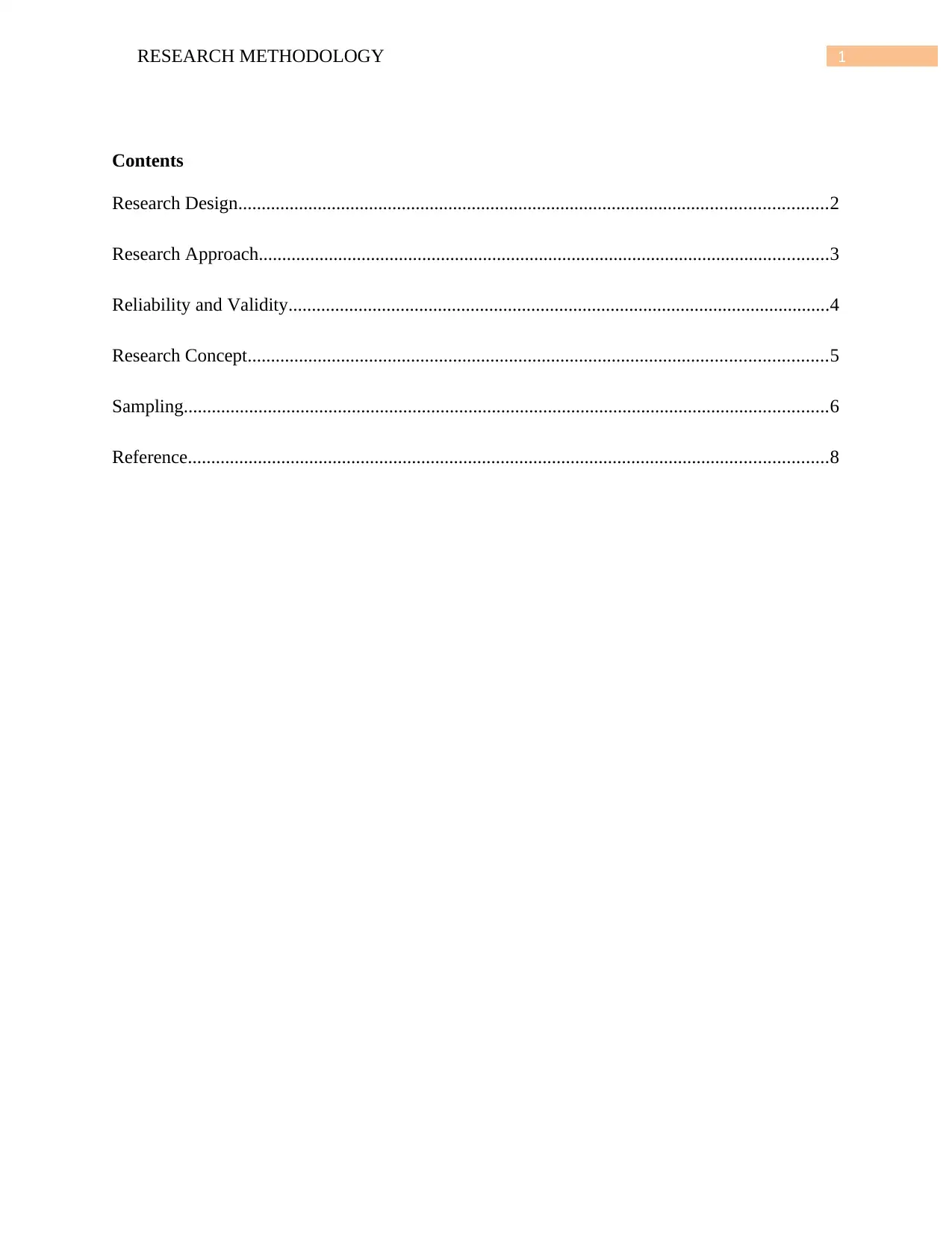
1RESEARCH METHODOLOGY
Contents
Research Design..............................................................................................................................2
Research Approach..........................................................................................................................3
Reliability and Validity....................................................................................................................4
Research Concept............................................................................................................................5
Sampling..........................................................................................................................................6
Reference.........................................................................................................................................8
Contents
Research Design..............................................................................................................................2
Research Approach..........................................................................................................................3
Reliability and Validity....................................................................................................................4
Research Concept............................................................................................................................5
Sampling..........................................................................................................................................6
Reference.........................................................................................................................................8
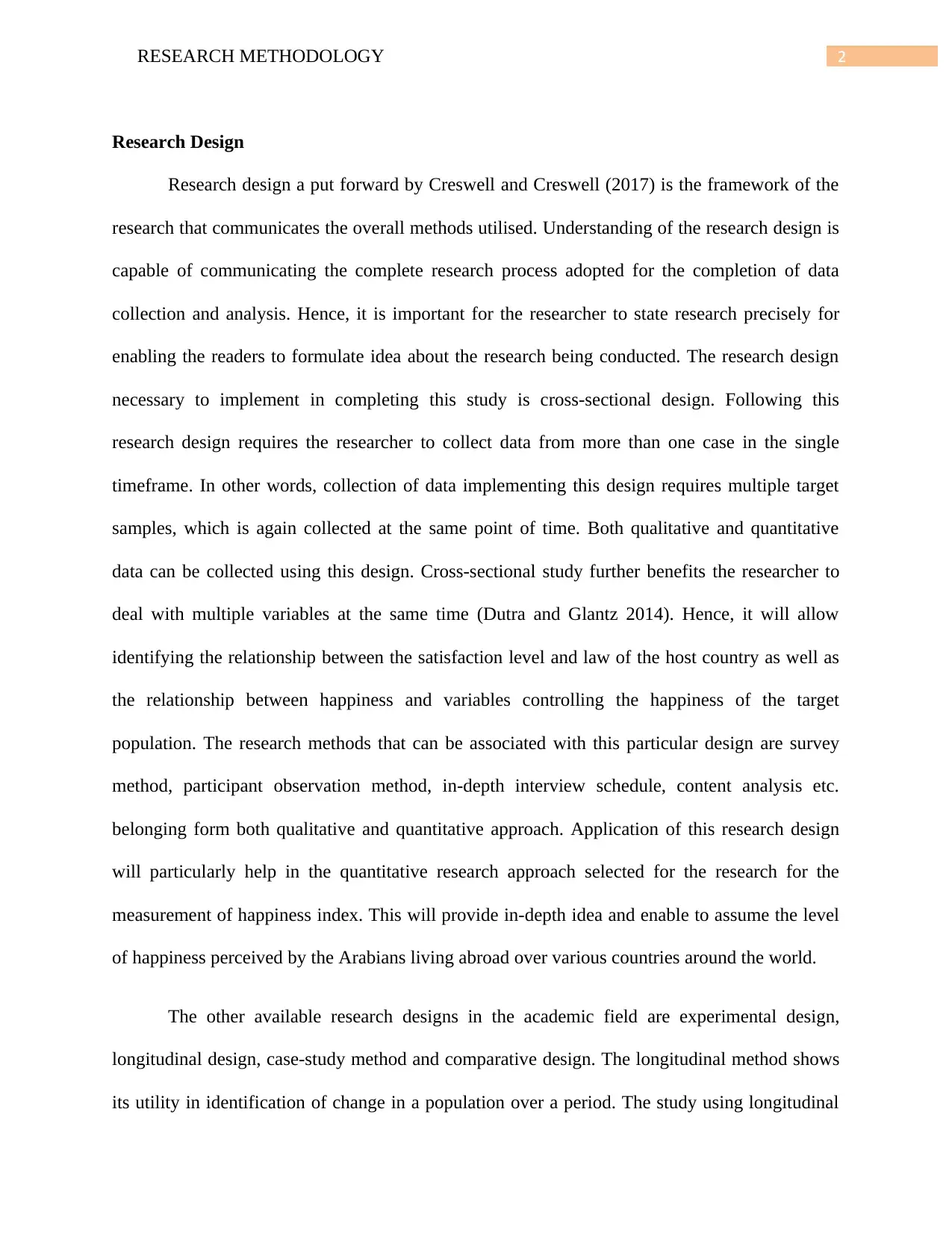
2RESEARCH METHODOLOGY
Research Design
Research design a put forward by Creswell and Creswell (2017) is the framework of the
research that communicates the overall methods utilised. Understanding of the research design is
capable of communicating the complete research process adopted for the completion of data
collection and analysis. Hence, it is important for the researcher to state research precisely for
enabling the readers to formulate idea about the research being conducted. The research design
necessary to implement in completing this study is cross-sectional design. Following this
research design requires the researcher to collect data from more than one case in the single
timeframe. In other words, collection of data implementing this design requires multiple target
samples, which is again collected at the same point of time. Both qualitative and quantitative
data can be collected using this design. Cross-sectional study further benefits the researcher to
deal with multiple variables at the same time (Dutra and Glantz 2014). Hence, it will allow
identifying the relationship between the satisfaction level and law of the host country as well as
the relationship between happiness and variables controlling the happiness of the target
population. The research methods that can be associated with this particular design are survey
method, participant observation method, in-depth interview schedule, content analysis etc.
belonging form both qualitative and quantitative approach. Application of this research design
will particularly help in the quantitative research approach selected for the research for the
measurement of happiness index. This will provide in-depth idea and enable to assume the level
of happiness perceived by the Arabians living abroad over various countries around the world.
The other available research designs in the academic field are experimental design,
longitudinal design, case-study method and comparative design. The longitudinal method shows
its utility in identification of change in a population over a period. The study using longitudinal
Research Design
Research design a put forward by Creswell and Creswell (2017) is the framework of the
research that communicates the overall methods utilised. Understanding of the research design is
capable of communicating the complete research process adopted for the completion of data
collection and analysis. Hence, it is important for the researcher to state research precisely for
enabling the readers to formulate idea about the research being conducted. The research design
necessary to implement in completing this study is cross-sectional design. Following this
research design requires the researcher to collect data from more than one case in the single
timeframe. In other words, collection of data implementing this design requires multiple target
samples, which is again collected at the same point of time. Both qualitative and quantitative
data can be collected using this design. Cross-sectional study further benefits the researcher to
deal with multiple variables at the same time (Dutra and Glantz 2014). Hence, it will allow
identifying the relationship between the satisfaction level and law of the host country as well as
the relationship between happiness and variables controlling the happiness of the target
population. The research methods that can be associated with this particular design are survey
method, participant observation method, in-depth interview schedule, content analysis etc.
belonging form both qualitative and quantitative approach. Application of this research design
will particularly help in the quantitative research approach selected for the research for the
measurement of happiness index. This will provide in-depth idea and enable to assume the level
of happiness perceived by the Arabians living abroad over various countries around the world.
The other available research designs in the academic field are experimental design,
longitudinal design, case-study method and comparative design. The longitudinal method shows
its utility in identification of change in a population over a period. The study using longitudinal
⊘ This is a preview!⊘
Do you want full access?
Subscribe today to unlock all pages.

Trusted by 1+ million students worldwide
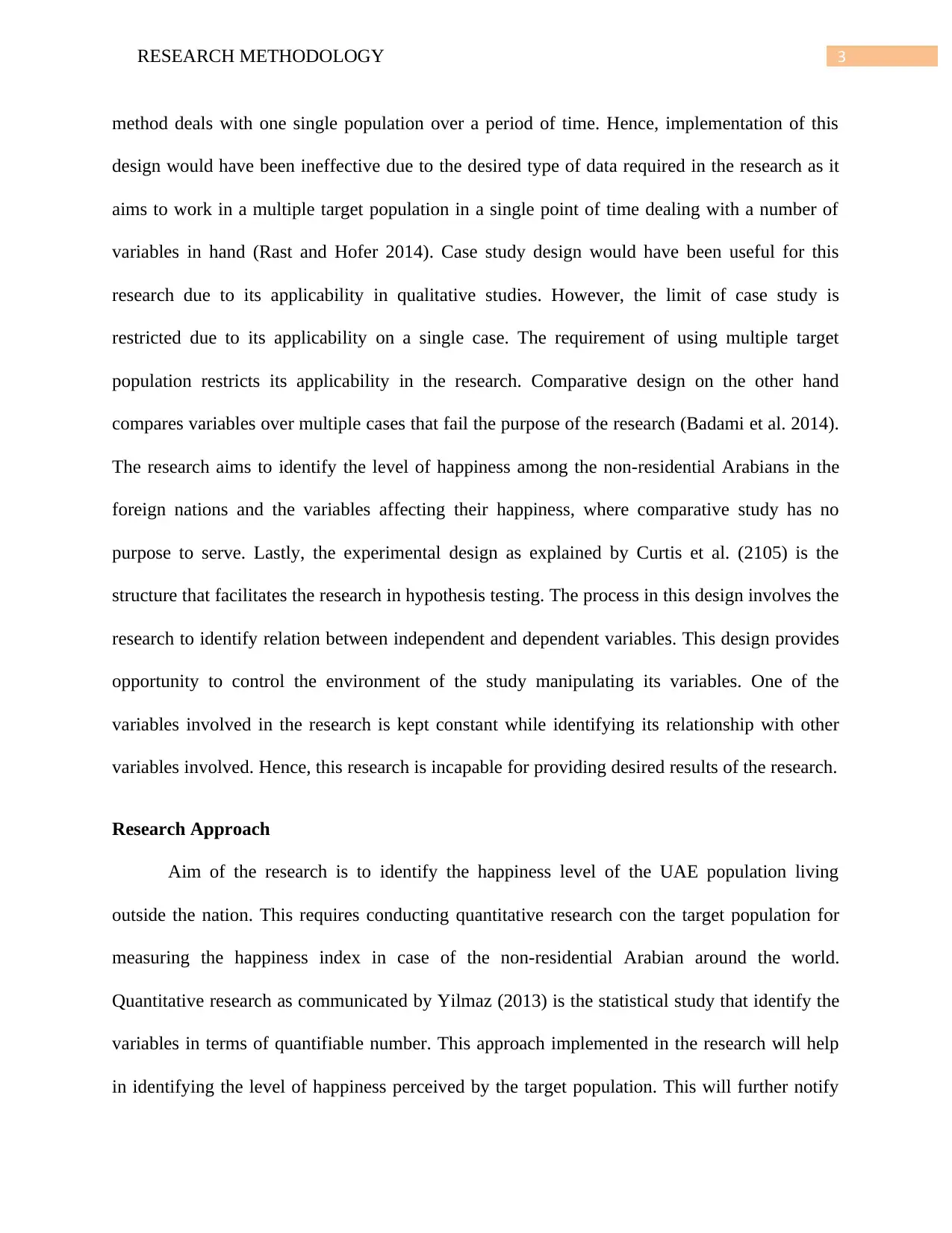
3RESEARCH METHODOLOGY
method deals with one single population over a period of time. Hence, implementation of this
design would have been ineffective due to the desired type of data required in the research as it
aims to work in a multiple target population in a single point of time dealing with a number of
variables in hand (Rast and Hofer 2014). Case study design would have been useful for this
research due to its applicability in qualitative studies. However, the limit of case study is
restricted due to its applicability on a single case. The requirement of using multiple target
population restricts its applicability in the research. Comparative design on the other hand
compares variables over multiple cases that fail the purpose of the research (Badami et al. 2014).
The research aims to identify the level of happiness among the non-residential Arabians in the
foreign nations and the variables affecting their happiness, where comparative study has no
purpose to serve. Lastly, the experimental design as explained by Curtis et al. (2105) is the
structure that facilitates the research in hypothesis testing. The process in this design involves the
research to identify relation between independent and dependent variables. This design provides
opportunity to control the environment of the study manipulating its variables. One of the
variables involved in the research is kept constant while identifying its relationship with other
variables involved. Hence, this research is incapable for providing desired results of the research.
Research Approach
Aim of the research is to identify the happiness level of the UAE population living
outside the nation. This requires conducting quantitative research con the target population for
measuring the happiness index in case of the non-residential Arabian around the world.
Quantitative research as communicated by Yilmaz (2013) is the statistical study that identify the
variables in terms of quantifiable number. This approach implemented in the research will help
in identifying the level of happiness perceived by the target population. This will further notify
method deals with one single population over a period of time. Hence, implementation of this
design would have been ineffective due to the desired type of data required in the research as it
aims to work in a multiple target population in a single point of time dealing with a number of
variables in hand (Rast and Hofer 2014). Case study design would have been useful for this
research due to its applicability in qualitative studies. However, the limit of case study is
restricted due to its applicability on a single case. The requirement of using multiple target
population restricts its applicability in the research. Comparative design on the other hand
compares variables over multiple cases that fail the purpose of the research (Badami et al. 2014).
The research aims to identify the level of happiness among the non-residential Arabians in the
foreign nations and the variables affecting their happiness, where comparative study has no
purpose to serve. Lastly, the experimental design as explained by Curtis et al. (2105) is the
structure that facilitates the research in hypothesis testing. The process in this design involves the
research to identify relation between independent and dependent variables. This design provides
opportunity to control the environment of the study manipulating its variables. One of the
variables involved in the research is kept constant while identifying its relationship with other
variables involved. Hence, this research is incapable for providing desired results of the research.
Research Approach
Aim of the research is to identify the happiness level of the UAE population living
outside the nation. This requires conducting quantitative research con the target population for
measuring the happiness index in case of the non-residential Arabian around the world.
Quantitative research as communicated by Yilmaz (2013) is the statistical study that identify the
variables in terms of quantifiable number. This approach implemented in the research will help
in identifying the level of happiness perceived by the target population. This will further notify
Paraphrase This Document
Need a fresh take? Get an instant paraphrase of this document with our AI Paraphraser
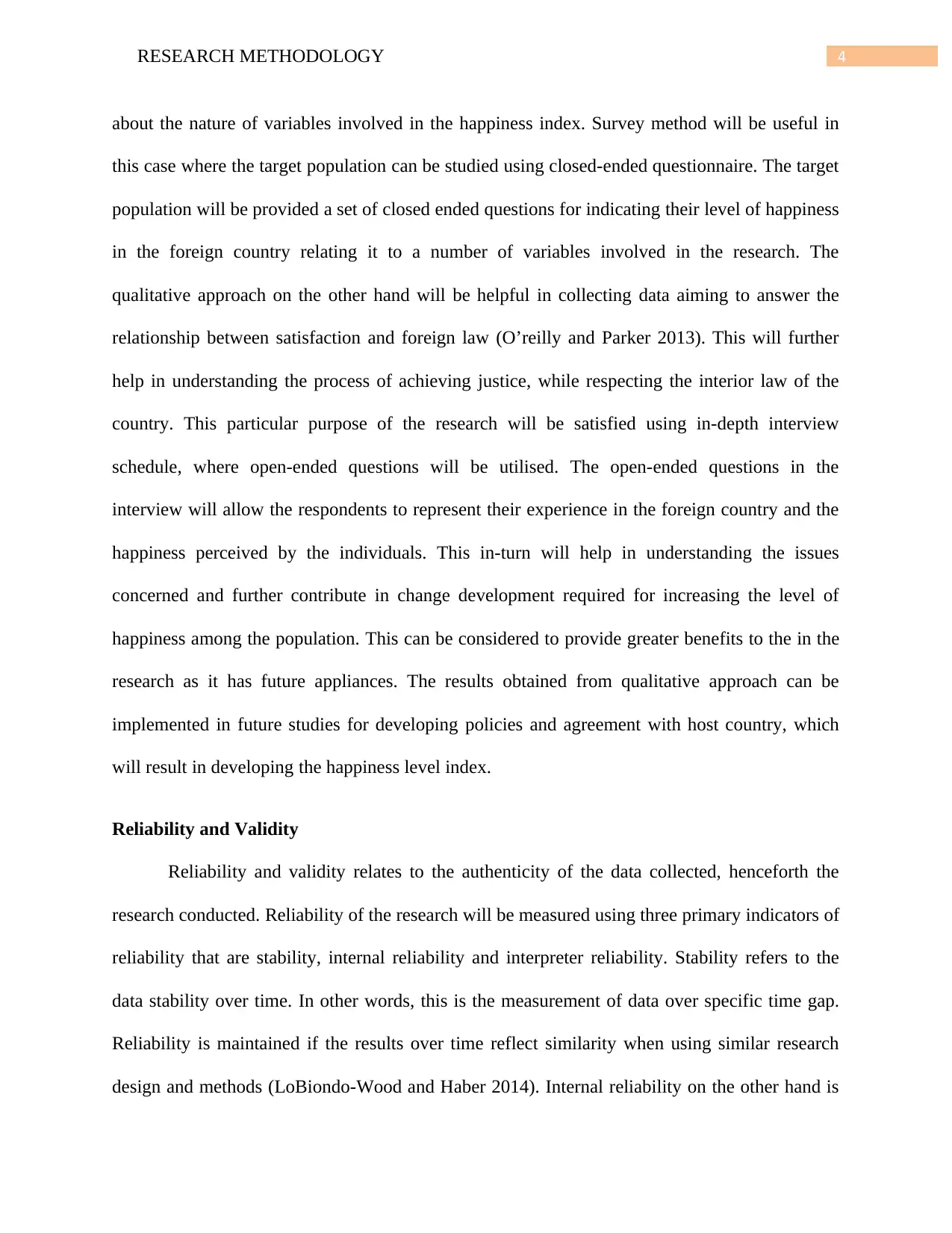
4RESEARCH METHODOLOGY
about the nature of variables involved in the happiness index. Survey method will be useful in
this case where the target population can be studied using closed-ended questionnaire. The target
population will be provided a set of closed ended questions for indicating their level of happiness
in the foreign country relating it to a number of variables involved in the research. The
qualitative approach on the other hand will be helpful in collecting data aiming to answer the
relationship between satisfaction and foreign law (O’reilly and Parker 2013). This will further
help in understanding the process of achieving justice, while respecting the interior law of the
country. This particular purpose of the research will be satisfied using in-depth interview
schedule, where open-ended questions will be utilised. The open-ended questions in the
interview will allow the respondents to represent their experience in the foreign country and the
happiness perceived by the individuals. This in-turn will help in understanding the issues
concerned and further contribute in change development required for increasing the level of
happiness among the population. This can be considered to provide greater benefits to the in the
research as it has future appliances. The results obtained from qualitative approach can be
implemented in future studies for developing policies and agreement with host country, which
will result in developing the happiness level index.
Reliability and Validity
Reliability and validity relates to the authenticity of the data collected, henceforth the
research conducted. Reliability of the research will be measured using three primary indicators of
reliability that are stability, internal reliability and interpreter reliability. Stability refers to the
data stability over time. In other words, this is the measurement of data over specific time gap.
Reliability is maintained if the results over time reflect similarity when using similar research
design and methods (LoBiondo-Wood and Haber 2014). Internal reliability on the other hand is
about the nature of variables involved in the happiness index. Survey method will be useful in
this case where the target population can be studied using closed-ended questionnaire. The target
population will be provided a set of closed ended questions for indicating their level of happiness
in the foreign country relating it to a number of variables involved in the research. The
qualitative approach on the other hand will be helpful in collecting data aiming to answer the
relationship between satisfaction and foreign law (O’reilly and Parker 2013). This will further
help in understanding the process of achieving justice, while respecting the interior law of the
country. This particular purpose of the research will be satisfied using in-depth interview
schedule, where open-ended questions will be utilised. The open-ended questions in the
interview will allow the respondents to represent their experience in the foreign country and the
happiness perceived by the individuals. This in-turn will help in understanding the issues
concerned and further contribute in change development required for increasing the level of
happiness among the population. This can be considered to provide greater benefits to the in the
research as it has future appliances. The results obtained from qualitative approach can be
implemented in future studies for developing policies and agreement with host country, which
will result in developing the happiness level index.
Reliability and Validity
Reliability and validity relates to the authenticity of the data collected, henceforth the
research conducted. Reliability of the research will be measured using three primary indicators of
reliability that are stability, internal reliability and interpreter reliability. Stability refers to the
data stability over time. In other words, this is the measurement of data over specific time gap.
Reliability is maintained if the results over time reflect similarity when using similar research
design and methods (LoBiondo-Wood and Haber 2014). Internal reliability on the other hand is
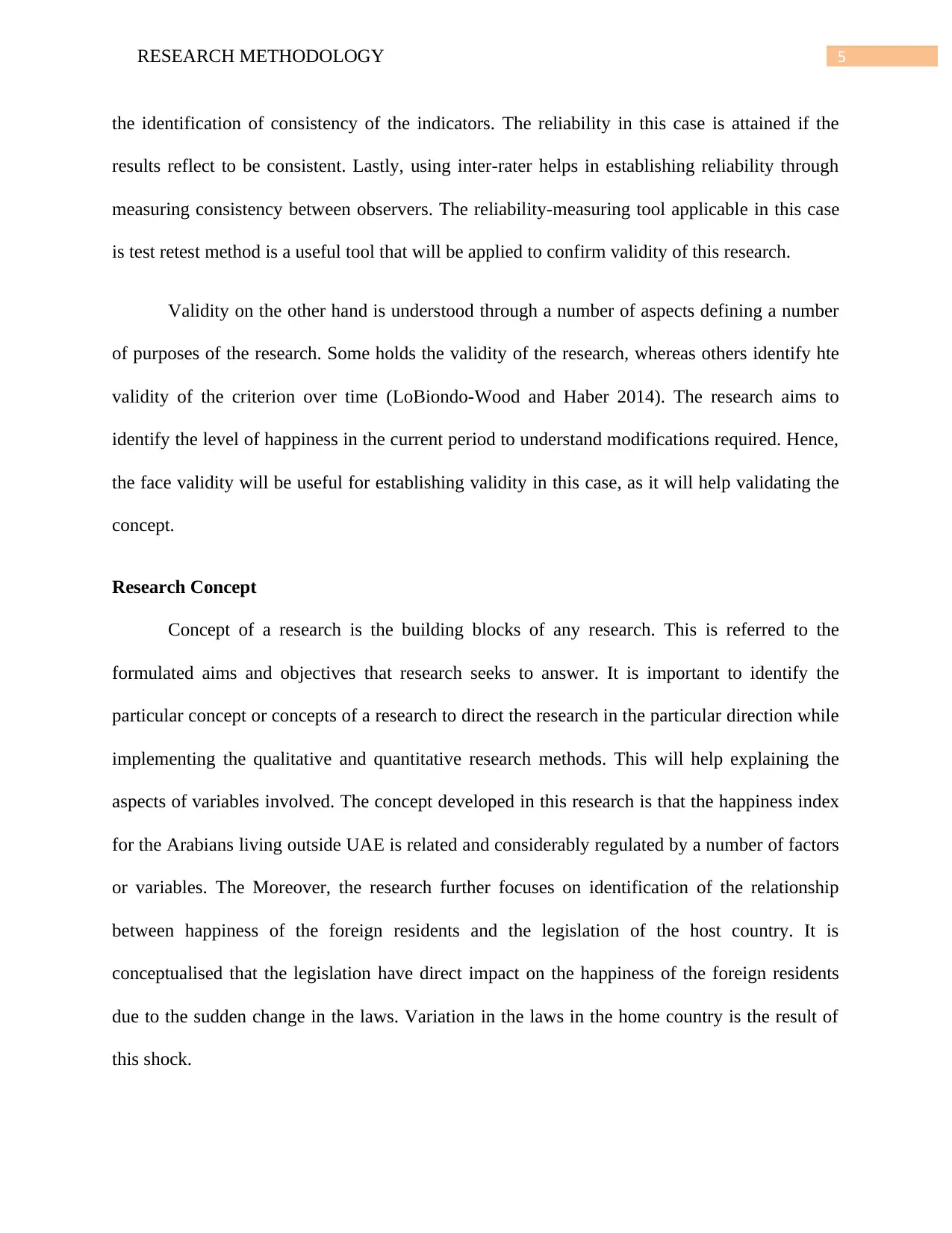
5RESEARCH METHODOLOGY
the identification of consistency of the indicators. The reliability in this case is attained if the
results reflect to be consistent. Lastly, using inter-rater helps in establishing reliability through
measuring consistency between observers. The reliability-measuring tool applicable in this case
is test retest method is a useful tool that will be applied to confirm validity of this research.
Validity on the other hand is understood through a number of aspects defining a number
of purposes of the research. Some holds the validity of the research, whereas others identify hte
validity of the criterion over time (LoBiondo-Wood and Haber 2014). The research aims to
identify the level of happiness in the current period to understand modifications required. Hence,
the face validity will be useful for establishing validity in this case, as it will help validating the
concept.
Research Concept
Concept of a research is the building blocks of any research. This is referred to the
formulated aims and objectives that research seeks to answer. It is important to identify the
particular concept or concepts of a research to direct the research in the particular direction while
implementing the qualitative and quantitative research methods. This will help explaining the
aspects of variables involved. The concept developed in this research is that the happiness index
for the Arabians living outside UAE is related and considerably regulated by a number of factors
or variables. The Moreover, the research further focuses on identification of the relationship
between happiness of the foreign residents and the legislation of the host country. It is
conceptualised that the legislation have direct impact on the happiness of the foreign residents
due to the sudden change in the laws. Variation in the laws in the home country is the result of
this shock.
the identification of consistency of the indicators. The reliability in this case is attained if the
results reflect to be consistent. Lastly, using inter-rater helps in establishing reliability through
measuring consistency between observers. The reliability-measuring tool applicable in this case
is test retest method is a useful tool that will be applied to confirm validity of this research.
Validity on the other hand is understood through a number of aspects defining a number
of purposes of the research. Some holds the validity of the research, whereas others identify hte
validity of the criterion over time (LoBiondo-Wood and Haber 2014). The research aims to
identify the level of happiness in the current period to understand modifications required. Hence,
the face validity will be useful for establishing validity in this case, as it will help validating the
concept.
Research Concept
Concept of a research is the building blocks of any research. This is referred to the
formulated aims and objectives that research seeks to answer. It is important to identify the
particular concept or concepts of a research to direct the research in the particular direction while
implementing the qualitative and quantitative research methods. This will help explaining the
aspects of variables involved. The concept developed in this research is that the happiness index
for the Arabians living outside UAE is related and considerably regulated by a number of factors
or variables. The Moreover, the research further focuses on identification of the relationship
between happiness of the foreign residents and the legislation of the host country. It is
conceptualised that the legislation have direct impact on the happiness of the foreign residents
due to the sudden change in the laws. Variation in the laws in the home country is the result of
this shock.
⊘ This is a preview!⊘
Do you want full access?
Subscribe today to unlock all pages.

Trusted by 1+ million students worldwide
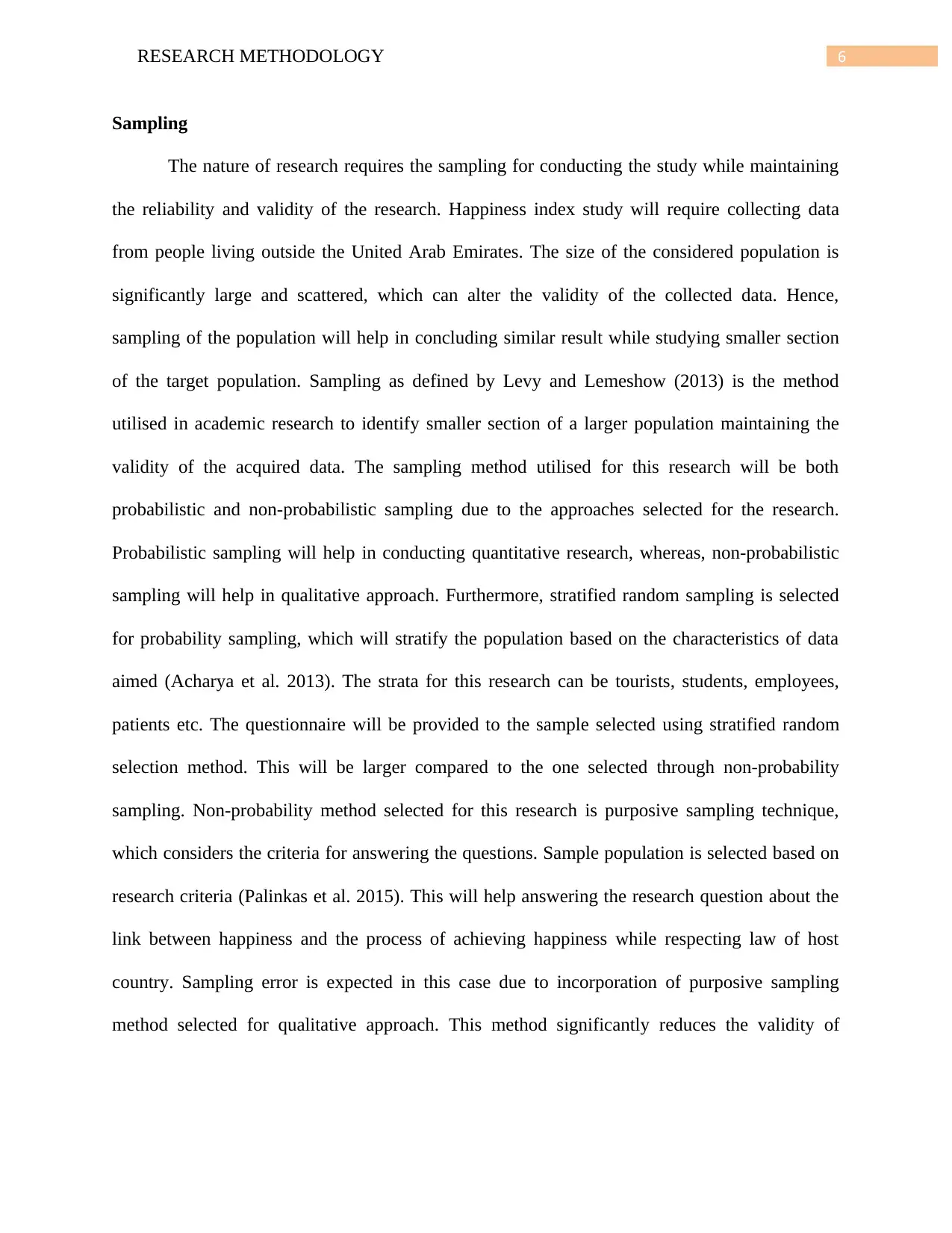
6RESEARCH METHODOLOGY
Sampling
The nature of research requires the sampling for conducting the study while maintaining
the reliability and validity of the research. Happiness index study will require collecting data
from people living outside the United Arab Emirates. The size of the considered population is
significantly large and scattered, which can alter the validity of the collected data. Hence,
sampling of the population will help in concluding similar result while studying smaller section
of the target population. Sampling as defined by Levy and Lemeshow (2013) is the method
utilised in academic research to identify smaller section of a larger population maintaining the
validity of the acquired data. The sampling method utilised for this research will be both
probabilistic and non-probabilistic sampling due to the approaches selected for the research.
Probabilistic sampling will help in conducting quantitative research, whereas, non-probabilistic
sampling will help in qualitative approach. Furthermore, stratified random sampling is selected
for probability sampling, which will stratify the population based on the characteristics of data
aimed (Acharya et al. 2013). The strata for this research can be tourists, students, employees,
patients etc. The questionnaire will be provided to the sample selected using stratified random
selection method. This will be larger compared to the one selected through non-probability
sampling. Non-probability method selected for this research is purposive sampling technique,
which considers the criteria for answering the questions. Sample population is selected based on
research criteria (Palinkas et al. 2015). This will help answering the research question about the
link between happiness and the process of achieving happiness while respecting law of host
country. Sampling error is expected in this case due to incorporation of purposive sampling
method selected for qualitative approach. This method significantly reduces the validity of
Sampling
The nature of research requires the sampling for conducting the study while maintaining
the reliability and validity of the research. Happiness index study will require collecting data
from people living outside the United Arab Emirates. The size of the considered population is
significantly large and scattered, which can alter the validity of the collected data. Hence,
sampling of the population will help in concluding similar result while studying smaller section
of the target population. Sampling as defined by Levy and Lemeshow (2013) is the method
utilised in academic research to identify smaller section of a larger population maintaining the
validity of the acquired data. The sampling method utilised for this research will be both
probabilistic and non-probabilistic sampling due to the approaches selected for the research.
Probabilistic sampling will help in conducting quantitative research, whereas, non-probabilistic
sampling will help in qualitative approach. Furthermore, stratified random sampling is selected
for probability sampling, which will stratify the population based on the characteristics of data
aimed (Acharya et al. 2013). The strata for this research can be tourists, students, employees,
patients etc. The questionnaire will be provided to the sample selected using stratified random
selection method. This will be larger compared to the one selected through non-probability
sampling. Non-probability method selected for this research is purposive sampling technique,
which considers the criteria for answering the questions. Sample population is selected based on
research criteria (Palinkas et al. 2015). This will help answering the research question about the
link between happiness and the process of achieving happiness while respecting law of host
country. Sampling error is expected in this case due to incorporation of purposive sampling
method selected for qualitative approach. This method significantly reduces the validity of
Paraphrase This Document
Need a fresh take? Get an instant paraphrase of this document with our AI Paraphraser
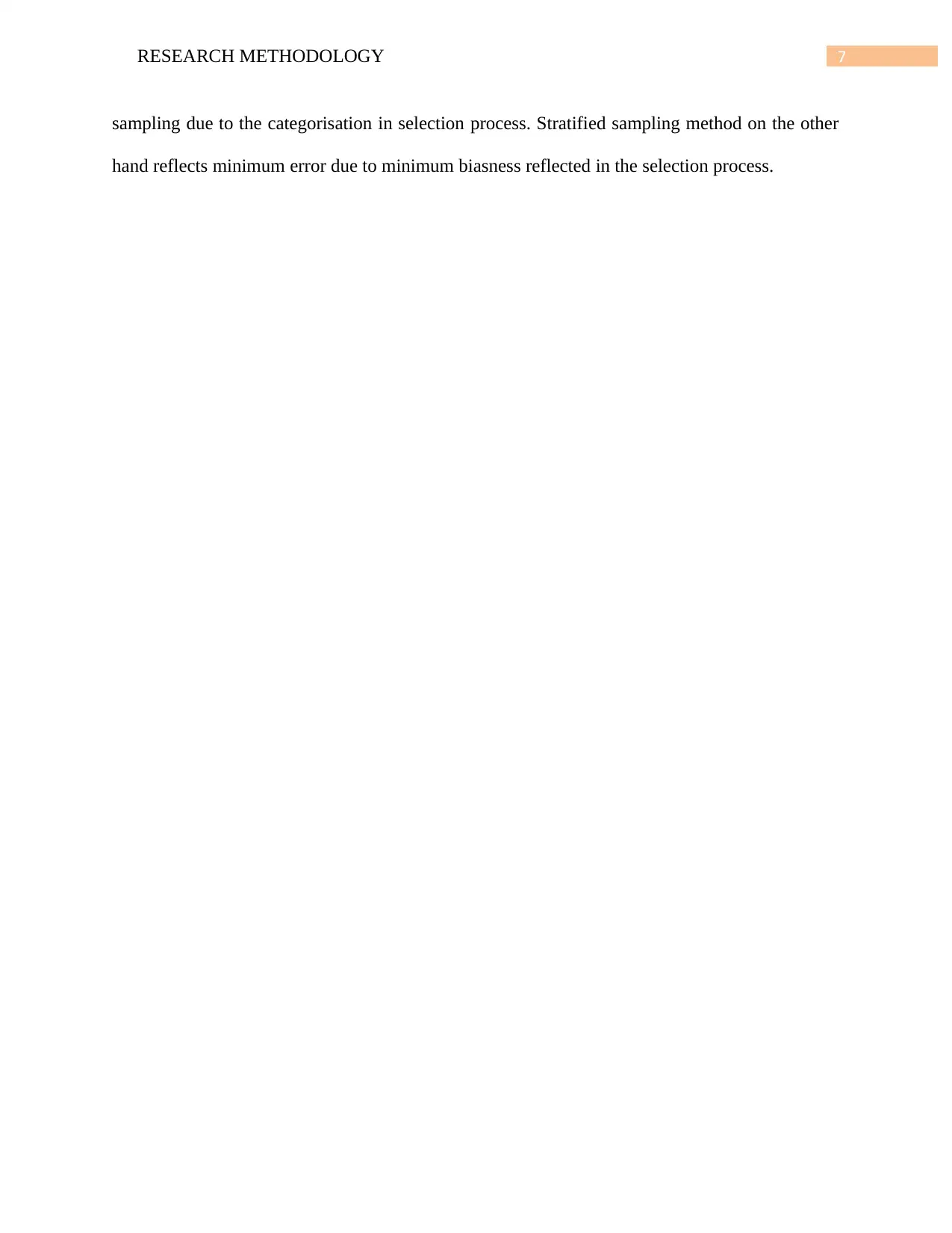
7RESEARCH METHODOLOGY
sampling due to the categorisation in selection process. Stratified sampling method on the other
hand reflects minimum error due to minimum biasness reflected in the selection process.
sampling due to the categorisation in selection process. Stratified sampling method on the other
hand reflects minimum error due to minimum biasness reflected in the selection process.
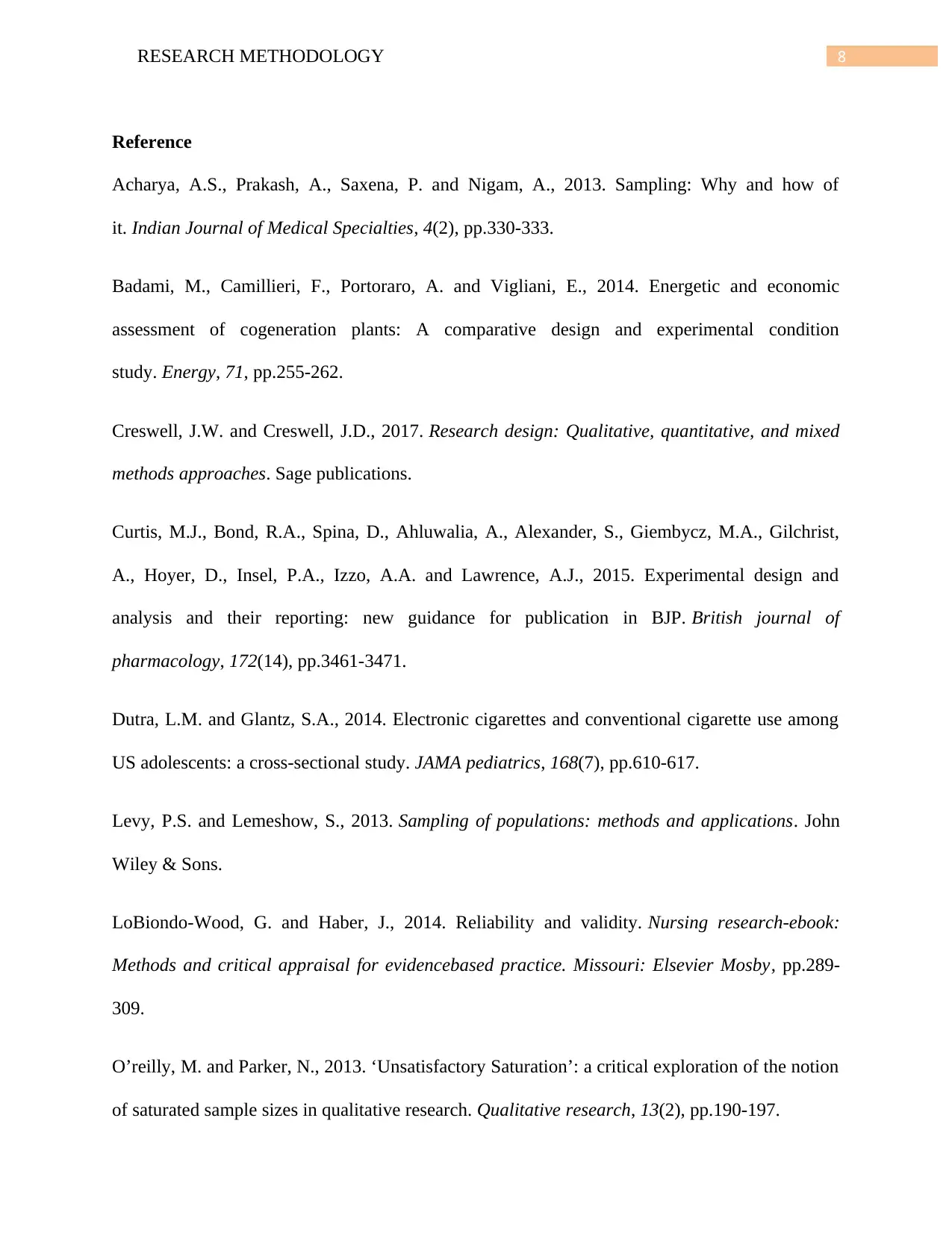
8RESEARCH METHODOLOGY
Reference
Acharya, A.S., Prakash, A., Saxena, P. and Nigam, A., 2013. Sampling: Why and how of
it. Indian Journal of Medical Specialties, 4(2), pp.330-333.
Badami, M., Camillieri, F., Portoraro, A. and Vigliani, E., 2014. Energetic and economic
assessment of cogeneration plants: A comparative design and experimental condition
study. Energy, 71, pp.255-262.
Creswell, J.W. and Creswell, J.D., 2017. Research design: Qualitative, quantitative, and mixed
methods approaches. Sage publications.
Curtis, M.J., Bond, R.A., Spina, D., Ahluwalia, A., Alexander, S., Giembycz, M.A., Gilchrist,
A., Hoyer, D., Insel, P.A., Izzo, A.A. and Lawrence, A.J., 2015. Experimental design and
analysis and their reporting: new guidance for publication in BJP. British journal of
pharmacology, 172(14), pp.3461-3471.
Dutra, L.M. and Glantz, S.A., 2014. Electronic cigarettes and conventional cigarette use among
US adolescents: a cross-sectional study. JAMA pediatrics, 168(7), pp.610-617.
Levy, P.S. and Lemeshow, S., 2013. Sampling of populations: methods and applications. John
Wiley & Sons.
LoBiondo-Wood, G. and Haber, J., 2014. Reliability and validity. Nursing research-ebook:
Methods and critical appraisal for evidencebased practice. Missouri: Elsevier Mosby, pp.289-
309.
O’reilly, M. and Parker, N., 2013. ‘Unsatisfactory Saturation’: a critical exploration of the notion
of saturated sample sizes in qualitative research. Qualitative research, 13(2), pp.190-197.
Reference
Acharya, A.S., Prakash, A., Saxena, P. and Nigam, A., 2013. Sampling: Why and how of
it. Indian Journal of Medical Specialties, 4(2), pp.330-333.
Badami, M., Camillieri, F., Portoraro, A. and Vigliani, E., 2014. Energetic and economic
assessment of cogeneration plants: A comparative design and experimental condition
study. Energy, 71, pp.255-262.
Creswell, J.W. and Creswell, J.D., 2017. Research design: Qualitative, quantitative, and mixed
methods approaches. Sage publications.
Curtis, M.J., Bond, R.A., Spina, D., Ahluwalia, A., Alexander, S., Giembycz, M.A., Gilchrist,
A., Hoyer, D., Insel, P.A., Izzo, A.A. and Lawrence, A.J., 2015. Experimental design and
analysis and their reporting: new guidance for publication in BJP. British journal of
pharmacology, 172(14), pp.3461-3471.
Dutra, L.M. and Glantz, S.A., 2014. Electronic cigarettes and conventional cigarette use among
US adolescents: a cross-sectional study. JAMA pediatrics, 168(7), pp.610-617.
Levy, P.S. and Lemeshow, S., 2013. Sampling of populations: methods and applications. John
Wiley & Sons.
LoBiondo-Wood, G. and Haber, J., 2014. Reliability and validity. Nursing research-ebook:
Methods and critical appraisal for evidencebased practice. Missouri: Elsevier Mosby, pp.289-
309.
O’reilly, M. and Parker, N., 2013. ‘Unsatisfactory Saturation’: a critical exploration of the notion
of saturated sample sizes in qualitative research. Qualitative research, 13(2), pp.190-197.
⊘ This is a preview!⊘
Do you want full access?
Subscribe today to unlock all pages.

Trusted by 1+ million students worldwide
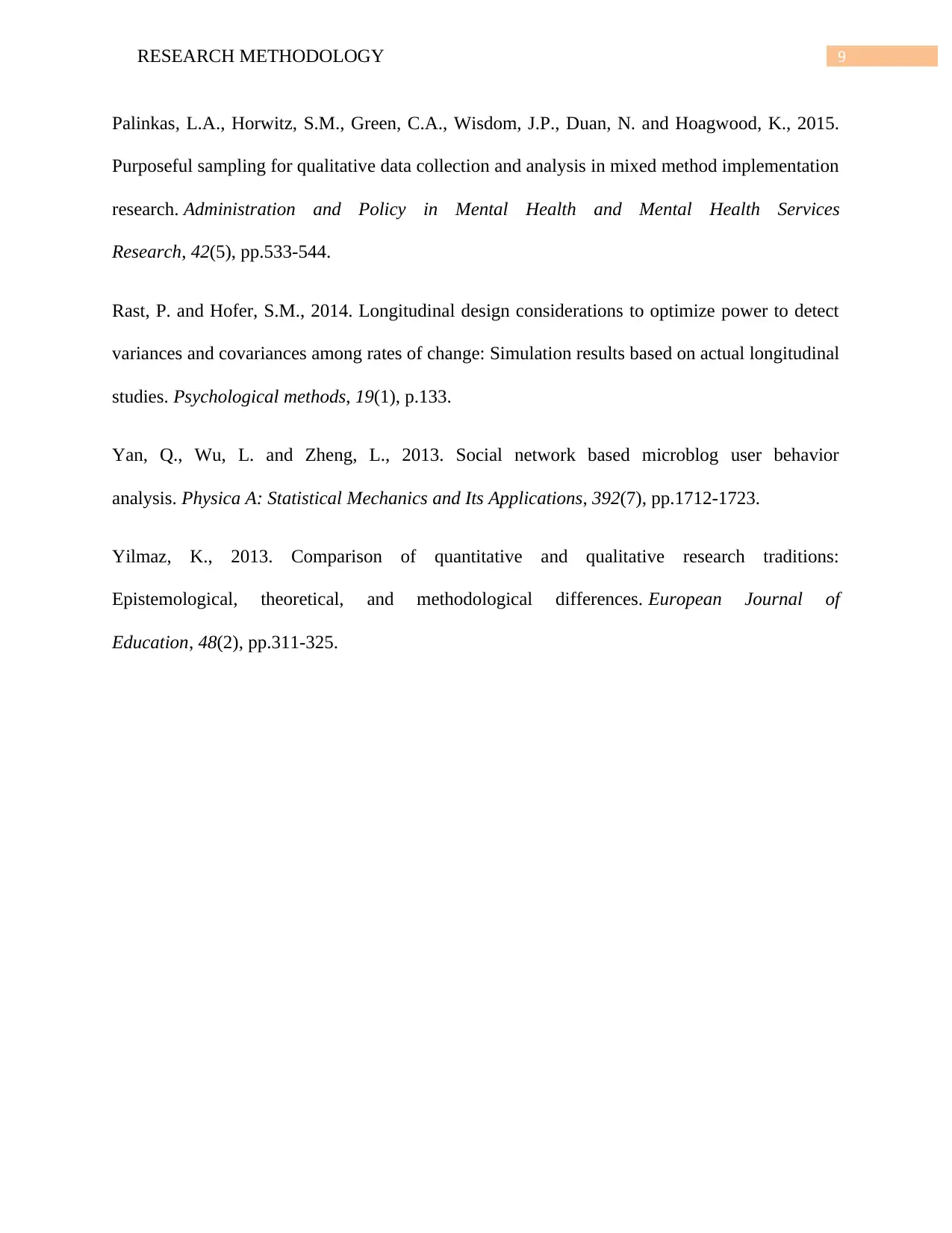
9RESEARCH METHODOLOGY
Palinkas, L.A., Horwitz, S.M., Green, C.A., Wisdom, J.P., Duan, N. and Hoagwood, K., 2015.
Purposeful sampling for qualitative data collection and analysis in mixed method implementation
research. Administration and Policy in Mental Health and Mental Health Services
Research, 42(5), pp.533-544.
Rast, P. and Hofer, S.M., 2014. Longitudinal design considerations to optimize power to detect
variances and covariances among rates of change: Simulation results based on actual longitudinal
studies. Psychological methods, 19(1), p.133.
Yan, Q., Wu, L. and Zheng, L., 2013. Social network based microblog user behavior
analysis. Physica A: Statistical Mechanics and Its Applications, 392(7), pp.1712-1723.
Yilmaz, K., 2013. Comparison of quantitative and qualitative research traditions:
Epistemological, theoretical, and methodological differences. European Journal of
Education, 48(2), pp.311-325.
Palinkas, L.A., Horwitz, S.M., Green, C.A., Wisdom, J.P., Duan, N. and Hoagwood, K., 2015.
Purposeful sampling for qualitative data collection and analysis in mixed method implementation
research. Administration and Policy in Mental Health and Mental Health Services
Research, 42(5), pp.533-544.
Rast, P. and Hofer, S.M., 2014. Longitudinal design considerations to optimize power to detect
variances and covariances among rates of change: Simulation results based on actual longitudinal
studies. Psychological methods, 19(1), p.133.
Yan, Q., Wu, L. and Zheng, L., 2013. Social network based microblog user behavior
analysis. Physica A: Statistical Mechanics and Its Applications, 392(7), pp.1712-1723.
Yilmaz, K., 2013. Comparison of quantitative and qualitative research traditions:
Epistemological, theoretical, and methodological differences. European Journal of
Education, 48(2), pp.311-325.
1 out of 10
Related Documents
Your All-in-One AI-Powered Toolkit for Academic Success.
+13062052269
info@desklib.com
Available 24*7 on WhatsApp / Email
![[object Object]](/_next/static/media/star-bottom.7253800d.svg)
Unlock your academic potential
Copyright © 2020–2025 A2Z Services. All Rights Reserved. Developed and managed by ZUCOL.





![Business Research Methodology Assignment - [University Name]](/_next/image/?url=https%3A%2F%2Fdesklib.com%2Fmedia%2Fimages%2Ftc%2F83c04ddc07264065ad727bb3f9c2b655.jpg&w=256&q=75)